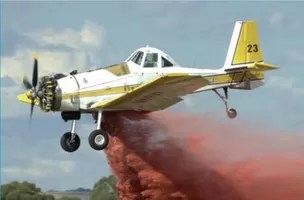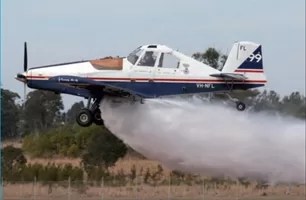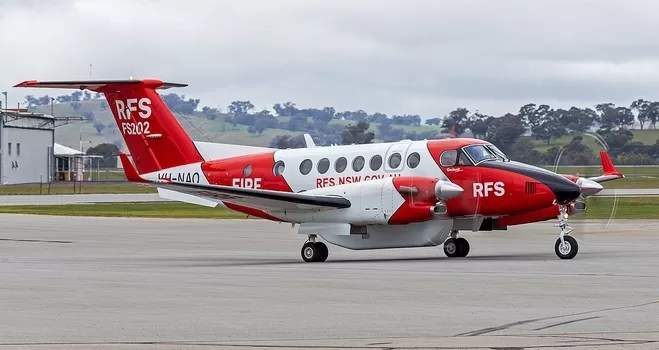The New South Wales Rural Fire Service (NSW RFS) is renowned for its unwavering commitment to protecting lives, property, and the environment from the devastating effects of bushfires. One of the most critical components of their firefighting arsenal is their diverse and sophisticated aircraft fleet.
These airborne warriors play a pivotal role in combating fires, conducting reconnaissance, and ensuring the safety of ground crews. Let’s take a closer look at the various aircraft in the NSW RFS fleet and their specific roles in firefighting operations.
Advertisement:
The NSW Rural Fire Service Aircraft Fleet
Coulson Aviation Australia oversees the management, operation and maintenance of the entire NSW RFS fleet. The fleet includes 11 aircraft - a 737 large air tanker, two Cessna Citations, six Bell-412 helicopters, a Chinook helicopter, and a Beechcraft Super King Air.
737 Large Air Tanker (LAT)

The 737 Large Air Tanker, often referred to as “Marie Bashir,” is a cornerstone of the NSW RFS aerial firefighting fleet, with its home base at the RAAF Richmond Air Base.
This powerful aircraft is capable of carrying up to 15,000 liters of fire retardant or water, making it an invaluable asset in combating large and fast-moving bushfires.
The 737 LAT’s primary role is to deliver substantial volumes of fire retardant to create containment lines, slow the spread of fires, and protect critical infrastructure and communities. Its speed and capacity allow it to cover vast areas quickly, providing crucial support to ground crews.
“Marie Bashir” was named after The Honourable Dame Marie Bashir AD CVO FTSE, the state’s second longest serving Governor. The Marie Bashir” is registered as N138CG, and according to a question raised in NSW Parliament, is in the process of being registered in Australia with the usual VH- callsign. To follow the path of N138CG, see FlightAware.
Lockheed C-130H Hercules
C-130H TY, otherwise known as Bomber 132, is a former Norwegian military aircraft with a capacity of 15,141 litres (4,000 gallons) of retardant and is one of the world’s most powerful aerial firefighting aircraft due to its range and versatility.

This particular aircraft pictured is based in Busselton, Western Australia.
The C-130H features Coulson Aviation’s proprietary RADS-XXL roll-on roll-off tanking system.
RADS stands for “Retardant Aerial Delivery System,” and this versatile tank can be installed on virtually any C-130 aircraft, according to the company.
Thor, a C130 fixed wing aircraft based in NSW, was sent on a five day deployment to assist in Indonesia in 2015.
Cessna Citation Jet Aircraft
The NSW Rural Fire Service (RFS) owns two Cessna Citation aircraft outfitted with advanced line scanning and infrared (IR) capabilities, to perform critical fire mapping, flood assessment and monitoring tasks.
These aircraft play a dual role, not only assisting in firefighting operations but also in scanning and mapping flood-affected areas for the NSW State Emergency Service. Additionally, they transport emergency responders across the state, highlighting their versatility and vital role in disaster response.

NSW Rural Fire Service, Cessna 560 Citation V, operated by Coulson Aviation, callsign VH-VJT. Photo by Bidgee under the Creative Commons Attribution-Share Alike 3.0 Australia license.
See where the NSW RFS Citation VH-VJT is now, click here.
During a fire, the Cessna Citations utilize sophisticated hardware and software systems operated by a Geographic Information System (GIS) operator stationed in the rear of the aircraft. These systems enable the aircraft to generate high-resolution scans from altitudes ranging between 12,000 and 20,000 feet, producing images with pixel resolutions as fine as 2.5 centimeters. The data collected is immediately converted into KML shapefiles, which are crucial for rapid response and planning.
The gathered information is transmitted back to the operations center, where staff use specialized software to create detailed maps of the affected areas. This process includes flight planning approval, which is seamlessly integrated and transmitted to the aircraft, allowing for real-time adjustments and coordination. The onboard systems also automatically send scanned data back to the operations center for interpretation, facilitating the coordination of further airborne firefighting operations.
Bell 412 Helicopter

This advanced mapping system is also installed in the Bell 412 helicopters, equipped with high-resolution FLIR 380HDc cameras.
While the Cessna Citations are primarily used for long-term response planning, the Bell 412 helicopters are adept at mapping current fires or new outbreaks caused by lightning strikes.
This capability enables the operations center to accurately pinpoint fire lines and direct both ground and aerial assets effectively.
The Bell 412 helicopter is a versatile and agile aircraft used for a variety of firefighting tasks. The Bell 412s are also essential for communicating evacuation orders and other critical information to the public. Three of these versatile helicopters are strategically stationed around the state, ready for regional fire, search and rescue, and other emergency operations.
Equipped with a water bucket or a belly tank, the Bell 412 can drop water directly onto fires, targeting hotspots and providing immediate relief to ground crews.
This helicopter is often used for reconnaissance missions, transporting personnel, and conducting aerial surveillance to assess fire behavior and map fire perimeters.
Its ability to hover and maneuver in challenging terrains makes it an essential tool in the NSW RFS fleet.
H-47 Chinook Helicopter

US-registered N47CU, a CH-47 Chinook twin-rotor helicopter modified for tanker and water-bomber operations in airborne firefighting, is known as Helitak 211 (HT211).
This impressive aircraft is leased from Coulson Aviation by the New South Wales Rural Fire Service (NSW RFS). It holds the distinction of being the largest-capacity firefighting helicopter permanently based in Australia, and it is equipped with nighttime aerial firefighting capabilities.
NSW RFS (N47CU) Boeing CH-47D Chinook helicopter. Photo by Bidgee under the Creative Commons Attribution-Share Alike 3.0 Australia license.
Air Tractor AT-802
The Air Tractor AT-802 is a single-engine, fixed-wing aircraft designed for both firefighting and agricultural applications.



From left: Radial Dromader; Ayres Thrush SR2 G10; Air Tractor AT-802.
Source: RFS Bushfire Bulletin/ Aviation Operations and Aircraft Recognition
In the NSW RFS fleet, the AT-802 is equipped with a 3,000-liter water tank, making it highly effective for rapid initial attack on small to medium-sized fires. Its agility allows it to operate in rugged and remote areas where larger aircraft may not be able to reach. The AT-802 is often used to douse spot fires, reinforce containment lines, and provide support to ground crews during mop-up operations.
Cessna 208 Caravan
The Cessna 208 Caravan serves as a vital reconnaissance and coordination aircraft in the NSW RFS fleet. This versatile aircraft is equipped with advanced mapping and surveillance equipment, enabling it to gather real-time data on fire behavior, assess damage, and identify potential threats. The Cessna 208 is also used for transporting personnel and supplies to remote locations, making it an indispensable asset for overall fire management and coordination efforts.

Eurocopter AS350 Squirrel
The Eurocopter AS350 Squirrel, also known as the “Squirrel,” is a light utility helicopter widely used by the NSW RFS for various firefighting tasks.
Its primary role includes aerial reconnaissance, providing real-time information to incident commanders, and directing ground crews to critical areas.
The AS350 is also equipped with a water bucket for targeted water drops on small fires and hotspots. Its speed, agility, and versatility make it a valuable asset in both firefighting and support operations.
BK117 Helicopter
The BK117 helicopter is another key component of the NSW RFS fleet, primarily used for medical evacuations and search and rescue missions during firefighting operations.
Equipped with advanced medical equipment and staffed with trained paramedics, the BK117 ensures the safety and well-being of both firefighters and civilians. Its ability to quickly access and evacuate injured personnel from firegrounds is crucial in emergency situations.


Left: VH-FRF, a twin-engined Kawaski B-117 helicopter. Photo, RFS
Right: VH-VRQ, Kawasaki Heavy Industries BK117 B-2 in new New South Wales Rural Fire Service livery. Photo by Bidgee under the Creative Commons Attribution-Share Alike 3.0 Australia license.
You can track VH-VRQ here to see where it is operating today.
Fixed-Wing Surveillance Aircraft
The NSW RFS also employs various fixed-wing surveillance aircraft, including the Piper PA-31 Navajo and the Beechcraft King Air. These aircraft are equipped with sophisticated imaging and mapping technology, allowing them to conduct detailed aerial surveys, monitor fire progression, and provide critical intelligence to ground teams. Their high-altitude capabilities enable them to cover large areas efficiently, enhancing situational awareness and strategic planning.

NSW Rural Fire Service, VH-NAO operated by Coulson Aviation, Beech King Air 350CER. Photo by Bidgee under the Creative Commons Attribution-Share Alike 3.0 Australia license.
You can track VH-NAO here to see where it is operating today.
Each aircraft in the NSW RFS aircraft fleet plays a unique and vital role in firefighting operations, from delivering massive volumes of fire retardant to conducting detailed reconnaissance and ensuring the safety of personnel.
As climate change continues to influence fire behavior, the importance of a well-equipped and versatile aerial firefighting fleet cannot be overstated. The NSW RFS remains at the forefront of firefighting innovation, ready to respond to any challenge that may arise.
By understanding the capabilities and roles of these incredible machines, we can better appreciate the immense effort and coordination required to keep our communities safe from the threat of bushfires.
Related stories
NSW RFS Aviation Fleet, NSW Rural Fire Service
RFS Firefighters Unite North America and Australasia
Integrating Indigenous Knowledge into Bushfire Management
Air Taxis Coming to Australia: A New Era in Urban Mobility
Mistake State Forest: A Battle for Preservation
Targeted Logging Threatens Great Koala National Park
Replacing timber power poles saves our forests
Advertisement:




